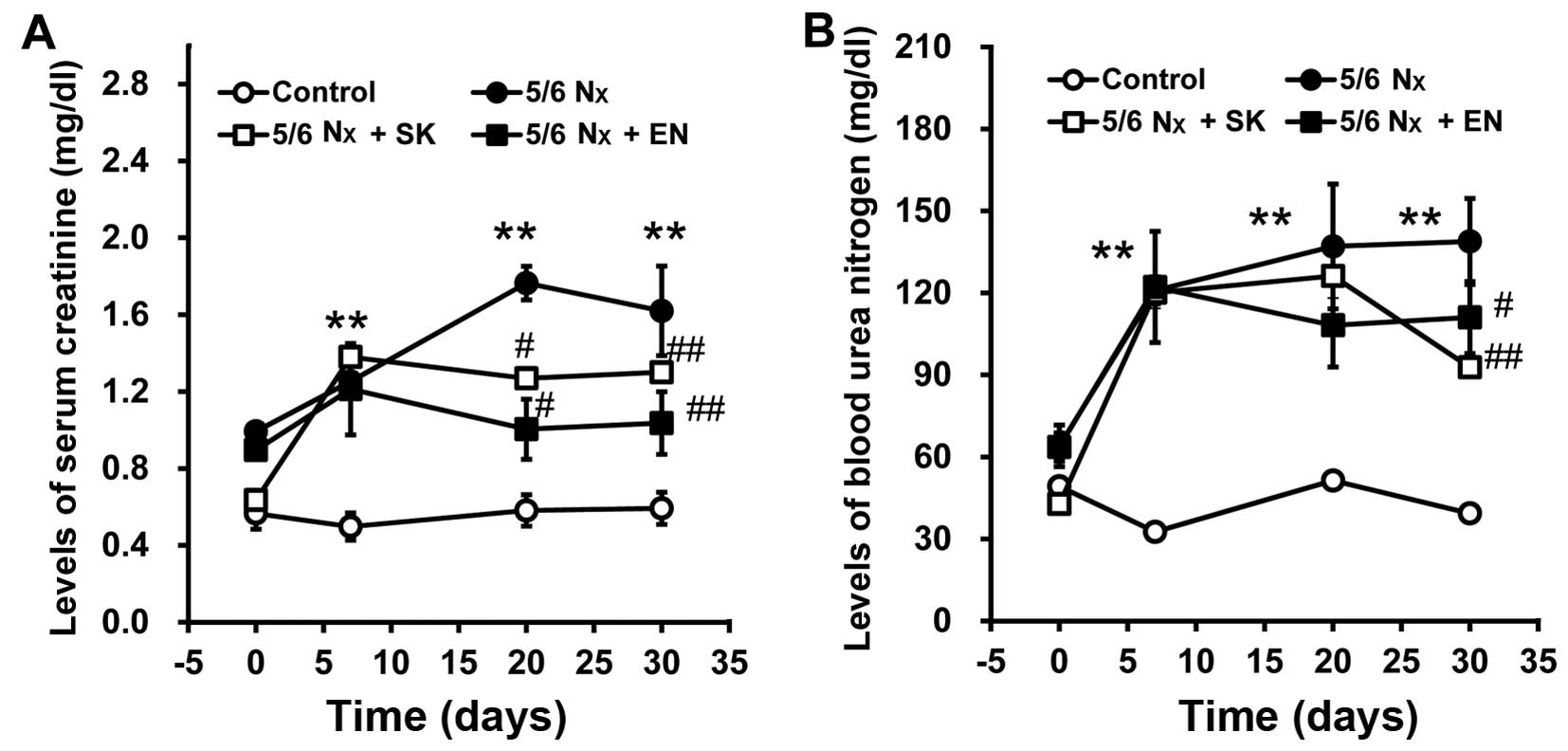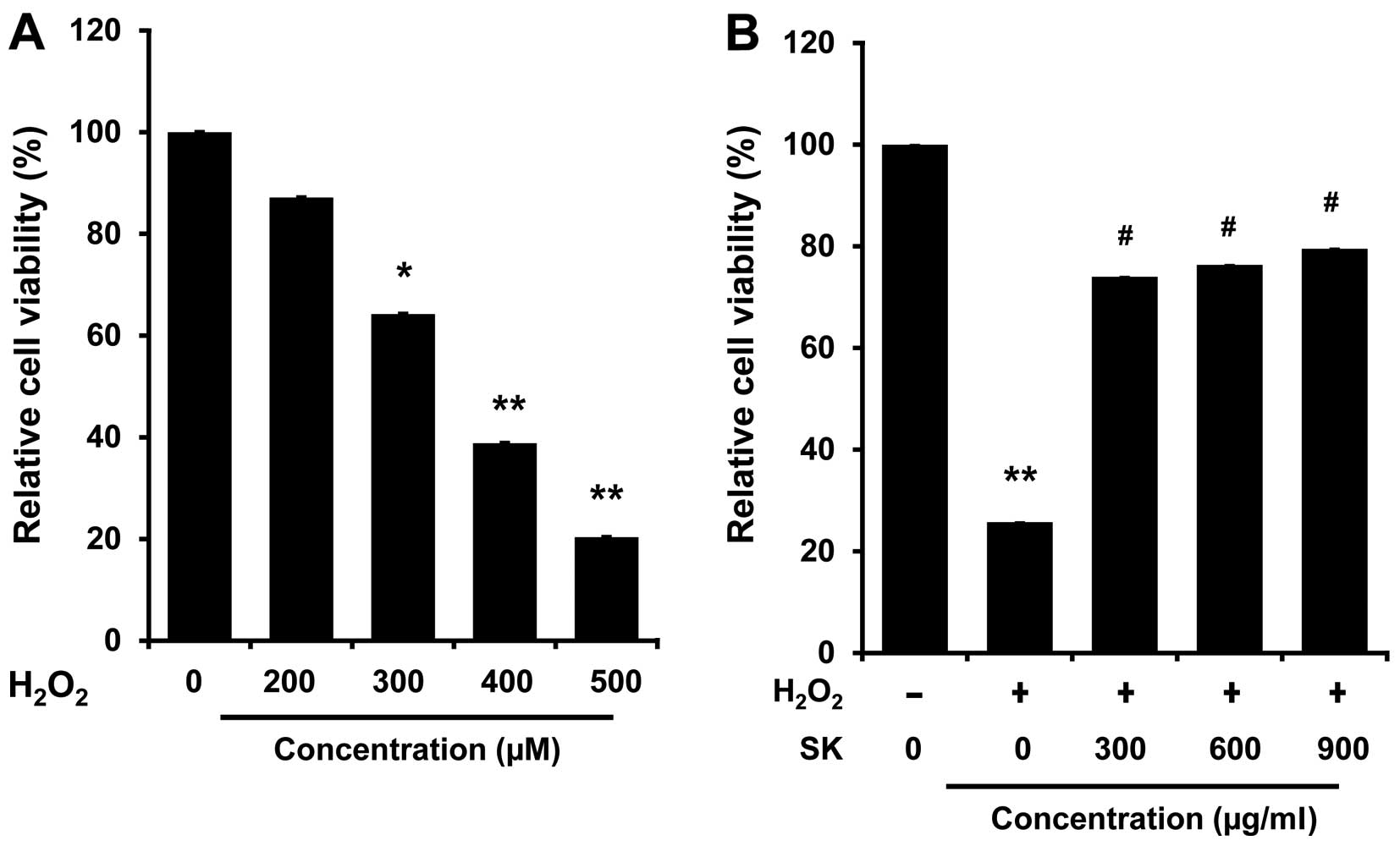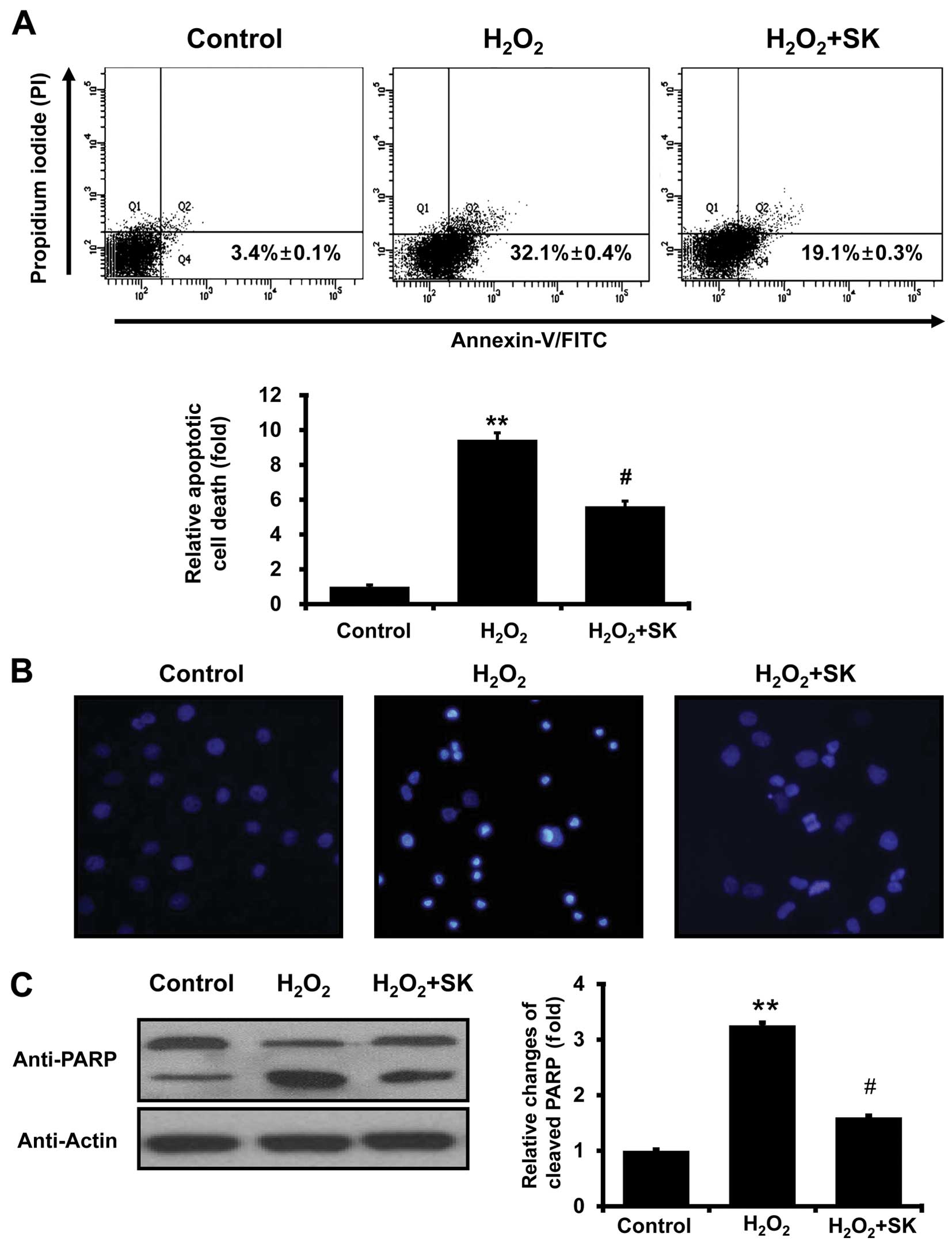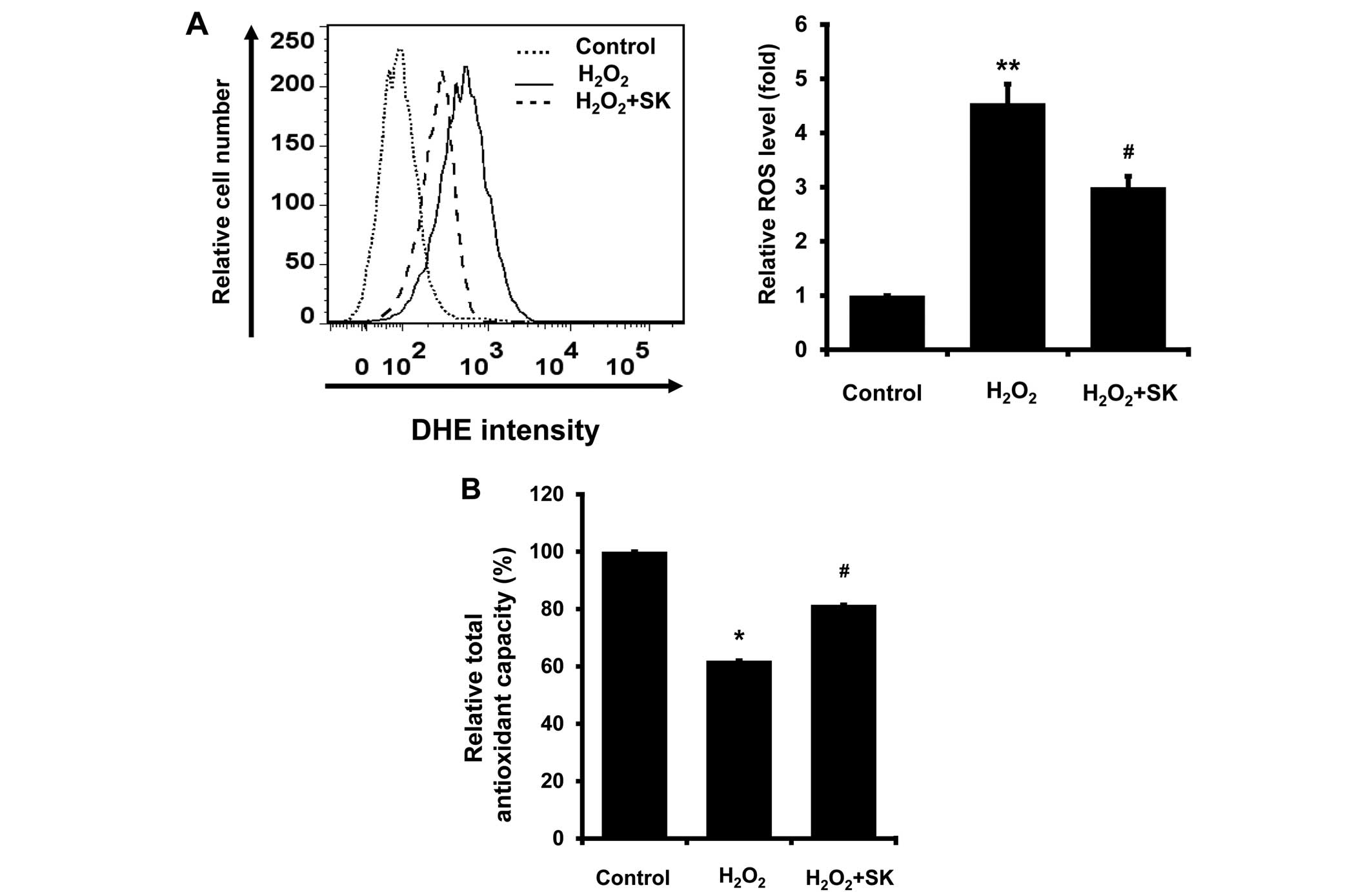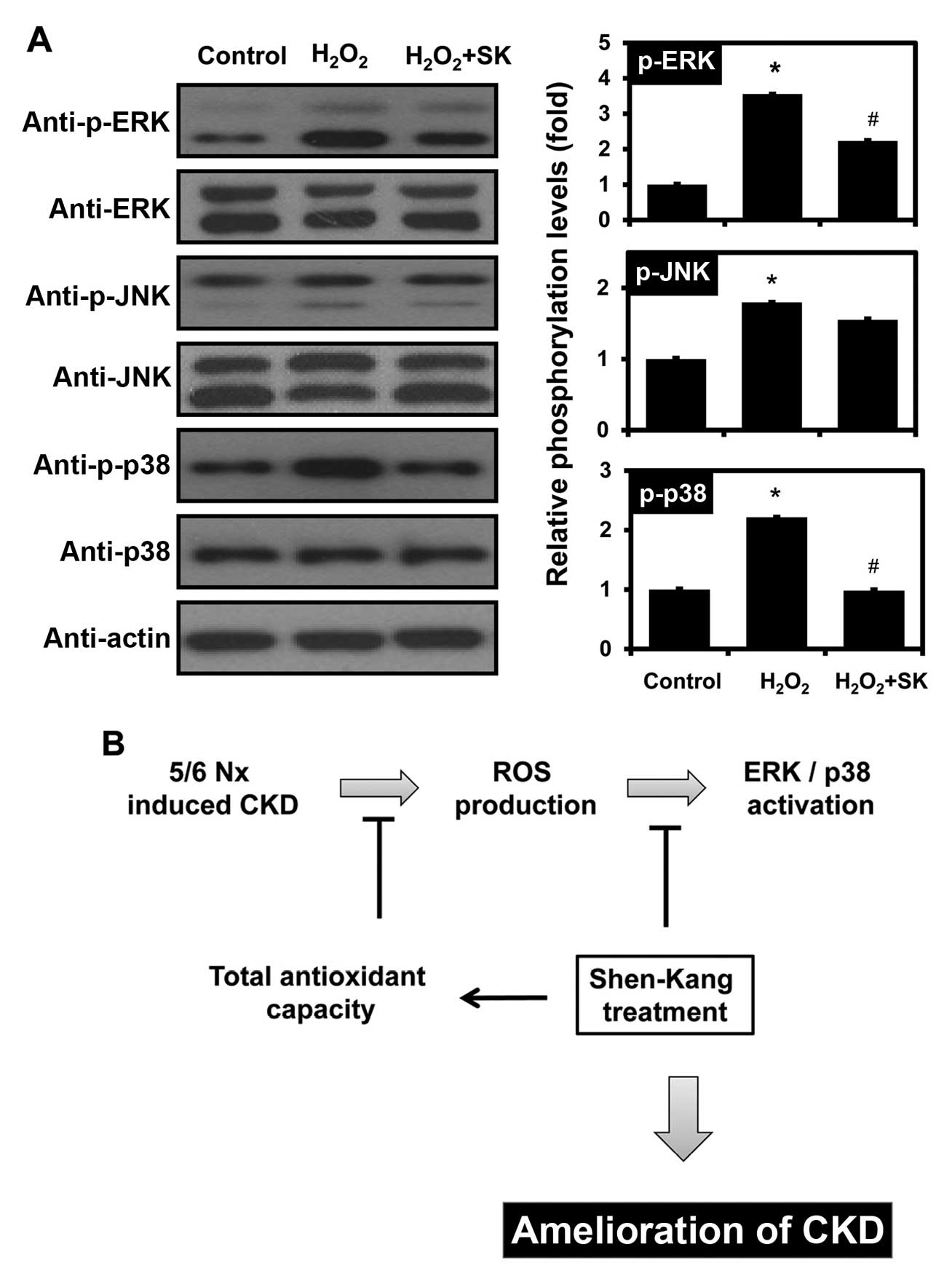|
1
|
Small DM and Gobe GC: Oxidative stress and
antioxidant therapy in chronic kidney and cardiovascular disease.
Oxidative Stress and Chronic Degenerative Diseases - A Role for
Antioxidants. Morales-Gonzales JA: InTech; pp. 233–264. 2013
|
|
2
|
Canaud G, Bienaimé F, Viau A, Treins C,
Baron W, Nguyen C, Burtin M, Berissi S, Giannakakis K, Muda AO, et
al: AKT2 is essential to maintain podocyte viability and function
during chronic kidney disease. Nat Med. 19:1288–1296. 2013.
View Article : Google Scholar : PubMed/NCBI
|
|
3
|
Impellizzeri D, Esposito E, Attley J and
Cuzzocrea S: Targeting inflammation: new therapeutic approaches in
chronic kidney disease (CKD). Pharmacol Res. 81:91–102. 2014.
View Article : Google Scholar : PubMed/NCBI
|
|
4
|
Suzuki Y, Yamaguchi I, Onoda N, Saito T,
Myojo K, Imaizumi M, Takada C, Kimoto N, Takaba K and Yamate J:
Differential renal glomerular changes induced by 5/6
nephrectomization between common marmoset monkeys (Callithrix
jacchus) and rats. Exp Toxicol Pathol. 65:667–676. 2013. View Article : Google Scholar
|
|
5
|
Fedorova LV, Tamirisa A, Kennedy DJ,
Haller ST, Budnyy G, Shapiro JI and Malhotra D: Mitochondrial
impairment in the five-sixth nephrectomy model of chronic renal
failure: proteomic approach. BMC Nephrol. 14:2092013. View Article : Google Scholar : PubMed/NCBI
|
|
6
|
Chen JF, Liu H, Ni HF, Lv LL, Zhang MH,
Zhang AH, Tang RN, Chen PS and Liu BC: Improved mitochondrial
function underlies the protective effect of pirfenidone against
tubulointerstitial fibrosis in 5/6 nephrectomized rats. PLoS One.
8:e835932013. View Article : Google Scholar : PubMed/NCBI
|
|
7
|
Albersmeyer M, Hilge R, Schröttle A, Weiss
M, Sitter T and Vielhauer V: Acute kidney injury after ingestion of
rhubarb: secondary oxalate nephropathy in a patient with type 1
diabetes. BMC Nephrol. 13:1412012. View Article : Google Scholar : PubMed/NCBI
|
|
8
|
Hanzlicek AS, Roof CJ, Sanderson MW and
Grauer GF: The Effect of Chinese rhubarb, Rheum officinale, with
and without benazepril on the progression of naturally occurring
chronic kidney disease in cats. J Vet Intern Med. 28:1221–1228.
2014. View Article : Google Scholar : PubMed/NCBI
|
|
9
|
Wang J, Zhao Y, Xiao X, Li H, Zhao H,
Zhang P and Jin C: Assessment of the renal protection and
hepatotoxicity of rhubarb extract in rats. J Ethnopharmacol.
124:18–25. 2009. View Article : Google Scholar : PubMed/NCBI
|
|
10
|
Yan M, Zhang LY, Sun LX, Jiang ZZ and Xiao
XH: Nephrotoxicity study of total rhubarb anthraquinones on Sprague
Dawley rats using DNA microarrays. J Ethnopharmacol. 107:308–311.
2006. View Article : Google Scholar : PubMed/NCBI
|
|
11
|
Ahn YM, Kim SK, Lee SH, Ahn SY, Kang SW,
Chung JH, Kim SD and Lee BC: Renoprotective effect of Tanshinone
IIA, an active component of Salvia miltiorrhiza, on rats with
chronic kidney disease. Phytother Res. 24:1886–1892. 2010.
View Article : Google Scholar : PubMed/NCBI
|
|
12
|
Behradmanesh S, Derees F and
Rafieian-Kopaei M: Effect of Salvia officinalis on diabetic
patients. J Renal Inj Prev. 2:51–54. 2013.PubMed/NCBI
|
|
13
|
Chen G, Fu Y and Wu X: Protective effect
of Salvia miltiorrhiza extract against renal
ischemia-reperfusion-induced injury in rats. Molecules.
17:1191–1202. 2012. View Article : Google Scholar : PubMed/NCBI
|
|
14
|
Guan S, Ma J, Zhang Y, Gao Y, Zhang Y,
Zhang X, Wang N, Xie Y, Wang J, Zhang J, et al: Danshen (Salvia
miltiorrhiza) injection suppresses kidney injury induced by iron
overload in mice. PLoS One. 8:e743182013. View Article : Google Scholar : PubMed/NCBI
|
|
15
|
Lee SH, Kim YS, Lee SJ and Lee BC: The
protective effect of Salvia miltiorrhiza in an animal model of
early experimentally induced diabetic nephropathy. J
Ethnopharmacol. 137:1409–1414. 2011. View Article : Google Scholar : PubMed/NCBI
|
|
16
|
Li L, Zhang Y, Ma J, Dong W, Song Q, Zhang
J and Chu L: Salvia miltiorrhiza injection ameliorates renal damage
induced by lead exposure in mice. ScientificWorldJournal.
2014:5726972014.PubMed/NCBI
|
|
17
|
You Z, Xin Y, Liu Y, Han B, Zhang L, Chen
Y, Chen Y, Gu L, Gao H and Xuan Y: Protective effect of Salvia
miltiorrhiza e injection on N(G)-nitro-D-arginine induced nitric
oxide deficient and oxidative damage in rat kidney. Exp Toxicol
Pathol. 64:453–458. 2012. View Article : Google Scholar
|
|
18
|
Lo HC, Wang YH, Chiou HY, Lai SH and Yang
Y: Relative efficacy of casein or soya protein combined with palm
or safflower-seed oil on hyperuricaemia in rats. Br J Nutr.
104:67–75. 2010. View Article : Google Scholar : PubMed/NCBI
|
|
19
|
Yang YL, Chang SY, Teng HC, Liu YS, Lee
TC, Chuang LY, Guh JY, Chang FR, Liao TN, Huang JS, et al:
Safflower extract: a novel renal fibrosis antagonist that functions
by suppressing autocrine TGF-beta. J Cell Biochem. 104:908–919.
2008. View Article : Google Scholar : PubMed/NCBI
|
|
20
|
Bai F, Makino T, Kono K, Nagatsu A, Ono T
and Mizukami H: Calycosin and formononetin from astragalus root
enhance dimethylarginine dimethylaminohydrolase 2 and nitric oxide
synthase expressions in Madin Darby Canine Kidney II cells. J Nat
Med. 67:782–789. 2013. View Article : Google Scholar : PubMed/NCBI
|
|
21
|
Kim J, Moon E and Kwon S: Effect of
Astragalus membranaceus extract on diabetic nephropathy. Endocrinol
Diabetes Metab Case Rep. 2014:1400632014.PubMed/NCBI
|
|
22
|
Li M, Wang W, Xue J, Gu Y and Lin S:
Meta-analysis of the clinical value of Astragalus membranaceus in
diabetic nephropathy. J Ethnopharmacol. 133:412–419. 2011.
View Article : Google Scholar
|
|
23
|
Lian Y, Xie L, Chen M and Chen L: Effects
of an astragalus polysaccharide and rhein combination on apoptosis
in rats with chronic renal failure. Evid Based Complement Alternat
Med. 2014:2718622014.PubMed/NCBI
|
|
24
|
Nie Y, Li S, Yi Y, Su W, Chai X, Jia D and
Wang Q: Effects of astragalus injection on the TGFβ/Smad pathway in
the kidney in type 2 diabetic mice. BMC Complement Altern Med.
14:1482014. View Article : Google Scholar
|
|
25
|
Song J, Meng L, Li S, Qu L and Li X: A
combination of Chinese herbs, Astragalus membranaceus var.
mongholicus and Angelica sinensis, improved renal microvascular
insufficiency in 5/6 nephrectomized rats. Vascul Pharmacol.
50:185–193. 2009. View Article : Google Scholar : PubMed/NCBI
|
|
26
|
Zhang HW, Lin ZX, Xu C, Leung C and Chan
LS: Astragalus (a traditional Chinese medicine) for treating
chronic kidney disease. Cochrane Database Syst Rev.
10:CD0083692014.PubMed/NCBI
|
|
27
|
Zhang J, Xie X, Li C and Fu P: Systematic
review of the renal protective effect of Astragalus membranaceus
(root) on diabetic nephropathy in animal models. J Ethnopharmacol.
126:189–196. 2009. View Article : Google Scholar : PubMed/NCBI
|
|
28
|
Miyamoto Y, Iwao Y, Mera K, Watanabe H,
Kadowaki D, Ishima Y, Chuang VT, Sato K, Otagiri M and Maruyama T:
A uremic toxin, 3-carboxy-4-methyl-5-propyl-2-furanpropionate
induces cell damage to proximal tubular cells via the generation of
a radical intermediate. Biochem Pharmacol. 84:1207–1214. 2012.
View Article : Google Scholar : PubMed/NCBI
|
|
29
|
Small DM, Bennett NC, Roy S, Gabrielli BG,
Johnson DW and Gobe GC: Oxidative stress and cell senescence
combine to cause maximal renal tubular epithelial cell dysfunction
and loss in an in vitro model of kidney disease. Nephron Exp
Nephrol. 122:123–130. 2012. View Article : Google Scholar
|
|
30
|
Yu X, Liu H, Zou J, Zhu J, Xu X and Ding
X: Oxidative stress in 5/6 nephrectomized rat model: effect of
alpha-lipoic acid. Ren Fail. 34:907–914. 2012. View Article : Google Scholar : PubMed/NCBI
|
|
31
|
Lee KE, Kim EY, Kim CS, Choi JS, Bae EH,
Ma SK, Park JS, Jung YD, Kim SH, Lee JU and Kim SW:
Macrophage-stimulating protein attenuates hydrogen peroxide-induced
apoptosis in human renal HK-2 cells. Eur J Pharmacol. 715:304–311.
2013. View Article : Google Scholar : PubMed/NCBI
|
|
32
|
Zaza G, Granata S, Masola V, Rugiu C,
Fantin F, Gesualdo L, Schena FP and Lupo A: Downregulation of
nuclear-encoded genes of oxidative metabolism in dialyzed chronic
kidney disease patients. PLoS One. 8:e778472013. View Article : Google Scholar : PubMed/NCBI
|
|
33
|
Tapia E, Soto V, Ortiz-Vega KM,
Zarco-Márquez G, Molina-Jijón E, Cristóbal-García M, Santamaría J,
García-Niño WR, Correa F, Zazueta C and Pedraza-Chaverri J:
Curcumin induces Nrf2 nuclear translocation and prevents glomerular
hypertension, hyperfiltration, oxidant stress, and the decrease in
antioxidant enzymes in 5/6 nephrectomized rats. Oxid Med Cell
Longev. 2012:2690392012. View Article : Google Scholar : PubMed/NCBI
|
|
34
|
Lu JR, Han HY, Chen J, Xiong CX, Wang XH,
Hu J, Chen XF and Ma L: Protective effects of Bu-Shen-Huo-Xue
formula against 5/6 nephrectomy-induced chronic renal failure in
rats. Evid Based Complement Alternat Med.
2014:5898462014.PubMed/NCBI
|
|
35
|
Gava AL, Freitas FP, Balarini CM, Vasquez
EC and Meyrelles SS: Effects of 5/6 nephrectomy on renal function
and blood pressure in mice. Int J Physiol Pathophysiol Pharmacol.
4:167–173. 2012.PubMed/NCBI
|
|
36
|
Hamada K, Taniguchi Y, Shimamura Y, Inoue
K, Ogata K, Ishihara M, Horino T, Fujimoto S, Ohguro T, Yoshimoto
Y, et al: Serum level of soluble (pro)renin receptor is modulated
in chronic kidney disease. Clin Exp Nephrol. 17:848–856. 2013.
View Article : Google Scholar : PubMed/NCBI
|
|
37
|
Ding ZH, Xu LM, Wang SZ, Kou JQ, Xu YL,
Chen CX, Yu HP, Qin ZH and Xie Y: Ameliorating adriamycin-induced
chronic kidney disease in rats by orally administrated cardiotoxin
from Naja naja atra venom. Evid Based Complement Alternat Med.
2014:6217562014.PubMed/NCBI
|
|
38
|
Nagai J, Yamamoto A, Yumoto R and Takano
M: Albumin overload induces expression of hypoxia-inducible factor
1α and its target genes in HK-2 human renal proximal tubular cell
line. Biochem Biophys Res Commun. 434:670–675. 2013. View Article : Google Scholar : PubMed/NCBI
|
|
39
|
Kwon JT, Seo GB, Jo, Lee M, Kim HM, Shim
I, Lee BW, Yoon BI, Kim P and Choi K: Aluminum nanoparticles induce
ERK and p38MAPK activation in rat brain. Toxicol Res. 29:181–185.
2013. View Article : Google Scholar
|
|
40
|
Waly MI, Ali BH, Al-Lawati I and Nemmar A:
Protective effects of emodin against cisplatin-induced oxidative
stress in cultured human kidney (HEK 293) cells. J Appl Toxicol.
33:626–630. 2013. View Article : Google Scholar
|
|
41
|
Du J, Chen H and Wang XB: Effect of
shenkang injection on hypertrophy and expressions of p21 and p27 in
glomerular mesangial cells of rats cultured in high glucose.
Zhongguo Zhong Xi Yi Jie He Za Zhi. 26(Suppl): 68–71. 2006.In
Chinese.
|
|
42
|
Fu C, Song S and Shi Y: Observation on
effect of chongcao shenkang capsules in preventing and treating
acute renal failure in cases of hemorrhagic fever with renal
syndrome. Zhonghua Shi Yan He Lin Chuang Bing Du Xue Za Zhi.
13:188–190. 1999.In Chinese.
|
|
43
|
Guo L, Liu Y and Mao W: Contrast study on
effect of shenkang injection and benazepril on human glomerular
mesangial extracellular matrix. Zhongguo Zhong Xi Yi Jie He Za Zhi.
20:50–52. 2000.In Chinese.
|
|
44
|
Guo LZ, Mao W and Wang HM: Serological
study on inhibitory function of shenkang injection on glomerular
mesangial cell. Zhongguo Zhong Xi Yi Jie He Za Zhi. 21:531–533.
2001.In Chinese.
|
|
45
|
Xiao W, Wei LB, Ma Y, Long HB and Chen GB:
Renal protective effect of Shenkang pill on diabetic rats. Zhongguo
Zhong Yao Za Zhi. 31:1006–1009. 2006.In Chinese. PubMed/NCBI
|
|
46
|
Zhao Y, Wang JC, Li HY, Jia Q, Chen S, Xu
Z, Du X, Chen X, Lu L, Huang B and Long H: Shenkang pill
down-regulates AOPP-induced expression of inflammatory factor MCP-1
via a p38MAPK/NF-κB-dependent mechanism. Nan Fang Yi Ke Da Xue Xue
Bao. 34:1265–1271. 2014.In Chinese. PubMed/NCBI
|
|
47
|
Zhao Z, Li H and Zhang X: Effect of
shenkang injection on transforming growth factor-beta messenger
ribonucleic acid of LLC-PK1 renal tubular epithelial cells.
Zhongguo Zhong Xi Yi Jie He Za Zhi. 20:931–933. 2000.In
Chinese.
|
|
48
|
Chatterjee PK, Chatterjee BE, Pedersen H,
Sivarajah A, McDonald MC, Mota-Filipe H, Brown PA, Stewart KN,
Cuzzocrea S, Threadgill MD and Thiemermann C: 5-Aminoisoquinolinone
reduces renal injury and dysfunction caused by experimental
ischemia/reperfusion. Kidney Int. 65:499–509. 2004. View Article : Google Scholar : PubMed/NCBI
|
|
49
|
Park SM, Jung HC, Koak IS, Na HY, Woo JS,
Jung JS and Kim YK: Oxidant-induced cell death in renal epithelial
cells: differential effects of inorganic and organic
hydroperoxides. Pharmacol Toxicol. 92:43–50. 2003. View Article : Google Scholar : PubMed/NCBI
|
|
50
|
Khan Z and Pandey M: Role of kidney
biomarkers of chronic kidney disease: An update. Saudi J Biol Sci.
21:294–299. 2014. View Article : Google Scholar : PubMed/NCBI
|
|
51
|
Padullés A, Rama I, Llaudó I and Lloberas
N: Developments in renal pharmacogenomics and applications in
chronic kidney disease. Pharmgenomics Pers Med. 7:251–266.
2014.PubMed/NCBI
|
|
52
|
Junaid Nazar CM, Kindratt TB, Ahmad SM,
Ahmed M and Anderson J: Barriers to the successful practice of
chronic kidney diseases at the primary health care level; a
systematic review. J Renal Inj Prev. 3:61–67. 2014.PubMed/NCBI
|
|
53
|
Lenz O, Mekala DP, Patel DV, Fornoni A,
Metz D and Roth D: Barriers to successful care for chronic kidney
disease. BMC Nephrol. 6:112005. View Article : Google Scholar : PubMed/NCBI
|
|
54
|
Campbell RC, Sui X, Filippatos G, Love TE,
Wahle C, Sanders PW and Ahmed A: Association of chronic kidney
disease with outcomes in chronic heart failure: a
propensity-matched study. Nephrol Dial Transplant. 24:186–193.
2009. View Article : Google Scholar :
|
|
55
|
Onuigbo MA and Agbasi N: Chronic kidney
disease prediction is an inexact science: The concept of
'progressors' and 'nonprogressors'. World J Nephrol. 3:31–49. 2014.
View Article : Google Scholar : PubMed/NCBI
|
|
56
|
Goolsby MJ: National kidney foundation
guidelines for chronic kidney disease: evaluation, classification,
and stratification. J Am Acad Nurse Pract. 14:238–242. 2002.
View Article : Google Scholar : PubMed/NCBI
|
|
57
|
Kopple JD: National kidney foundation
K/DOQI clinical practice guidelines for nutrition in chronic renal
failure. Am J Kidney Dis. 37(Suppl 2): S66–S70. 2001. View Article : Google Scholar : PubMed/NCBI
|
|
58
|
Levey AS, Coresh J, Balk E, Kausz AT,
Levin A, Steffes MW, Hogg RJ, Perrone RD, Lau J and Eknoyan G;
National Kidney Foundation: National Kidney Foundation practice
guidelines for chronic kidney disease: evaluation, classification,
and stratification. Ann Intern Med. 139:137–147. 2003. View Article : Google Scholar : PubMed/NCBI
|
|
59
|
Li X and Wang H: Chinese herbal medicine
in the treatment of chronic kidney disease. Adv Chronic Kidney Dis.
12:276–281. 2005. View Article : Google Scholar : PubMed/NCBI
|
|
60
|
Normile D: Asian medicine. The new face of
traditional Chinese medicine. Science. 299:188–190. 2003.
View Article : Google Scholar : PubMed/NCBI
|
|
61
|
Zhong Y, Deng Y, Chen Y, Chuang PY and
Cijiang He J: Therapeutic use of traditional Chinese herbal
medications for chronic kidney diseases. Kidney Int. 84:1108–1118.
2013. View Article : Google Scholar : PubMed/NCBI
|
|
62
|
Xu Q, Bauer R, Hendry BM, Fan TP, Zhao Z,
Duez P, Simmonds MS, Witt CM, Lu A, Robinson N, et al: The quest
for modernisation of traditional Chinese medicine. BMC Complement
Altern Med. 13:1322013. View Article : Google Scholar : PubMed/NCBI
|
|
63
|
Wojcikowski K, Johnson DW and Gobe G:
Herbs or natural substances as complementary therapies for chronic
kidney disease: ideas for future studies. J Lab Clin Med.
147:160–166. 2006. View Article : Google Scholar : PubMed/NCBI
|
|
64
|
Santos LS, Chin EW, Ioshii SO and Tambara
Filho R: Surgical reduction of the renal mass in rats: morphologic
and functional analysis on the remnant kidney. Acta Cir Bras.
21:252–257. 2006. View Article : Google Scholar : PubMed/NCBI
|
|
65
|
Kren S and Hostetter TH: The course of the
remnant kidney model in mice. Kidney Int. 56:333–337. 1999.
View Article : Google Scholar : PubMed/NCBI
|
|
66
|
He L, Shen P, Fu Q, Li J, Dan M, Wang X
and Jia W: Nephro-protective effect of Kangqianling decoction on
chronic renal failure rats. J Ethnopharmacol. 122:367–373. 2009.
View Article : Google Scholar : PubMed/NCBI
|
|
67
|
Wen X, Wu J, Wang F, Liu B, Huang C and
Wei Y: Deconvoluting the role of reactive oxygen species and
autophagy in human diseases. Free Radic Biol Med. 65:402–410. 2013.
View Article : Google Scholar : PubMed/NCBI
|
|
68
|
Dettmering T, Zahnreich S, Colindres-Rojas
M, Durante M, Taucher-Scholz G and Fournier C: Increased
effectiveness of carbon ions in the production of reactive oxygen
species in normal human fibroblasts. J Radiat Res. 56:67–76. 2015.
View Article : Google Scholar
|
|
69
|
Qin XJ, He W, Hai CX, Liang X and Liu R:
Protection of multiple antioxidants Chinese herbal medicine on the
oxidative stress induced by adriamycin chemotherapy. J Appl
Toxicol. 28:271–282. 2008. View Article : Google Scholar
|
|
70
|
Bongartz LG, Cramer MJ, Doevendans PA,
Joles JA and Braam B: The severe cardiorenal syndrome: 'Guyton
revisited'. Eur Heart J. 26:11–17. 2005. View Article : Google Scholar
|
|
71
|
Tu Y, Sun W, Wan YG, Gao K, Liu H, Yu BY,
Hu H and Huang YR: Dahuang Fuzi Decoction ameliorates tubular
epithelial apoptosis and renal damage via inhibiting TGF-β1-JNK
signaling pathway activation in vivo. J Ethnopharmacol.
156:115–124. 2014. View Article : Google Scholar : PubMed/NCBI
|
|
72
|
Wankun X, Wenzhen Y, Min Z, Weiyan Z, Huan
C, Wei D, Lvzhen H, Xu Y and Xiaoxin L: Protective effect of
paeoniflorin against oxidative stress in human retinal pigment
epithelium in vitro. Mol Vis. 17:3512–3522. 2011.
|
|
73
|
Cao Y, Zhang Y, Wang N and He L:
Antioxidant effect of imperatorin from Angelica dahurica in
hypertension via inhibiting NADPH oxidase activation and MAPK
pathway. J Am Soc Hypertens. 8:527–536. 2014. View Article : Google Scholar : PubMed/NCBI
|
|
74
|
Chakraborti S and Chakraborti T:
Oxidant-mediated activation of mitogen-activated protein kinases
and nuclear transcription factors in the cardiovascular system: a
brief overview. Cell Signal. 10:675–683. 1998. View Article : Google Scholar
|
|
75
|
Li ZJ, Li XM, Piao YJ, Choi DK, Kim SJ,
Kim JW, Sohn KC, Kim CD and Lee JH: Genkwadaphnin induces reactive
oxygen species (ROS)-mediated apoptosis of squamous cell carcinoma
(SCC) cells. Biochem Biophys Res Commun. 450:1115–1119. 2014.
View Article : Google Scholar : PubMed/NCBI
|
|
76
|
Zhang W and Liu HT: MAPK signal pathways
in the regulation of cell proliferation in mammalian cells. Cell
Res. 12:9–18. 2002. View Article : Google Scholar : PubMed/NCBI
|
|
77
|
Shimizu H, Bolati D, Higashiyama Y,
Nishijima F, Shimizu K and Niwa T: Indoxyl sulfate upregulates
renal expression of MCP-1 via production of ROS and activation of
NF-κB, p53, ERK, and JNK in proximal tubular cells. Life Sci.
90:525–530. 2012. View Article : Google Scholar : PubMed/NCBI
|
|
78
|
Sung CC, Hsu YC, Chen CC, Lin YF and Wu
CC: Oxidative stress and nucleic acid oxidation in patients with
chronic kidney disease. Oxid Med Cell Longev. 2013:3019822013.
View Article : Google Scholar : PubMed/NCBI
|
|
79
|
Khan SR: Stress oxidative: nephrolithiasis
and chronic kidney diseases. Minerva Med. 104:23–30.
2013.PubMed/NCBI
|
|
80
|
Popolo A, Autore G, Pinto A and Marzocco
S: Oxidative stress in patients with cardiovascular disease and
chronic renal failure. Free Radic Res. 47:346–356. 2013. View Article : Google Scholar : PubMed/NCBI
|
|
81
|
Huang C, Day ML, Poronnik P, Pollock CA
and Chen XM: Inhibition of KCa3.1 suppresses TGF-β1 induced MCP-1
expression in human proximal tubular cells through Smad3, p38 and
ERK1/2 signaling pathways. Int J Biochem Cell Biol. 47:1–10. 2014.
View Article : Google Scholar
|
|
82
|
An P, Dang HM, Shi XM, Ye BY and Wu XL:
'Qufeng Tongluo' acupuncture prevents the progression of
glomerulonephritis by decreasing renal sympathetic nerve activity.
J Ethnopharmacol. 155:277–284. 2014. View Article : Google Scholar : PubMed/NCBI
|
|
83
|
Alcorn JF, van der Velden J, Brown AL,
McElhinney B, Irvin CG and Janssen-Heininger YM: c-Jun N-terminal
kinase 1 is required for the development of pulmonary fibrosis. Am
J Respir Cell Mol Biol. 40:422–432. 2009. View Article : Google Scholar :
|




